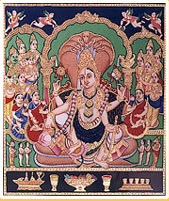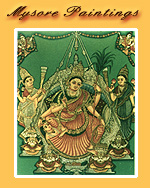Contribute
| South Asian Art History - In Memory Of Prashant H. Fadia |
Dr Ramaa Narayanan
08/21/2007
Mysore Paintings - Part II
Click here to read the first part of the article
The artists prepared themselves all the things needed for the painting, sourcing the required material from the nature around. A traditional Mysore Painting is done on cloth glued over an apparent board, made of many sheets of newspaper stuck together and then primed. Paper had made an early entry in Karnataka compared to other Southern territories; and often the painting is done on paper stuck over a board. The required sketch is then made free hand on the prepared board in pencil, the last having replaced the use of charcoal which was prepared by charring tamarind twigs in an iron tube. If available, ‘ready-drawing’ known as cartoon is transferred on to the board through carbon paper or pouncing. Traditionally, vegetable and mineral pigments obtained from various plants and stones were used for colouring; yielding at present times to painting with commercially available poster colours and water colours. Originally, the colours were prepared by grinding the raw material in a stone mortar adding water to make them in to a fine-grained, soft paste. Brushes were made essentially by inserting a sheaf of hair from squirrel, camel or goat in to the narrow hole of a quill or bamboo. Squirrel-hair brushes are preferred the most. Sometimes grass blades were also used to paint sharp and fine lines. Brushes of different grade available in the market facilitate the painting task and saves on labour and time involved in making them. Once the sketch is made, the gesso work that is normally done wherever embellishments are intended is taken up. The making of gesso - known as ‘maggu’ – is elaborate and tedious; and its preparation was held a secret. The synthetic binders, glue and textures offer ready substitutes in the recent times. When the gesso is dry completely, gold foil is placed over with greatest care, following the up-and-down details of the applied relief work. Actual painting is taken up subsequently, filling the areas in required tints and shades, and adding the details in fine brushwork. On completion, the painting is burnished by placing a thin paper over the work and rubbed softly with a smooth stone in order to bring out the richness in the relief work veneered in gold as well as to give the pigments an enamel like sheen.
Mysore Painting is known for its technical virtuosity and artistic merit. The composition is compact and the pictorial field unified; thus fulfilling its function as devotional pictures. The main figure is positioned in the center though not necessarily in a strictly frontal pose. However symmetry is maintained. When depicting a group of figures, hierarchy of scale is mandatory; wherein the main figure of god or goddess is the largest, the consorts and parivara devatas - ‘related deities’- are next in terms of size. The attendants and chhauri-bearers are smaller as are rishis and sages. Others like devotees and patrons or birds or animals as may be included are diminutive in comparison. The pictorial convention of scale has no symbolism of ‘order of creation’ and is followed for the reasons of glorification of the divine and as pictorial convention. Coupled with the theatrical setting the pictures offer heavenly visions of the divine images, especially when the gold in the painting glows in the flickering lamp light or in the light filtered off its glare as found in the interiors where they are usually hung. The relief work is low and flattish. The foil work of genuine gold is delicate. A wide range of colours, painted evenly and as shading create visually pleasing pictures. The composition has scope for inventiveness and imagination. Mysore paintings are free expressions of conventional drawings.
Mysore Painting remained a palace art over the centuries. Besides the palace at Mysore, the progenitors of Mysore Painting settled, mainly in Chitradurga and Madhugiri territories in the present day Karnataka. The art practice was hereditary and its knowledge was safeguarded from outsiders. At present, there are just a handful of families involved in this practice. Two aged artists, who worked directly under the Wodeyars are now helpful in their knowledge and wisdom though not practicing their art.. One of them - T.Narsipur has passed on the art to his son K.S.Seshadri who still prepares the yellows, reds and indigos from minerals and vegetable sources in the tedious yet worthy ways of the old, while acknowledging that working with chemical colours is easy and practical. A Brahmin named M.Ram Narasiah from Mysore had mastered the art with great difficulty.
In recent times, the art has come in the open. The specialized style is now imparted to willing learners at Chitra Kala Parishad in Bangalore by the traditional artist Y. Subramanya Raju, still active in his ripe old age. A few of the traditional artists are training others individually, too. There is an increase in demand for Mysore Paintings; along with is a growing sensitivity to the simplistic beauty of these pictures. Mysore palace and Chitra Kala Parishad at Mysore are the main repositories of old paintings. And apart from the many private collectors, Mysore Paintings adorn many a home.
The art of Mysore Painting has become wide spread; its themes are becoming wide based. New or old, Mysore Painting possesses high artistic merits when done by able and talentd artists. It delights the eye, captures the heart; And elevates the soul. In short, Mysore Painting is an art sublime.
Visuals of Mysore Painting :
Courtesy : RAASI ART FOUNDATION,
1, Anna Avenue, Bhaktavatsalam Nagar,
Chennai 600020
Website : www.raasiart.com
You may also access this article through our web-site http://www.lokvani.com/

